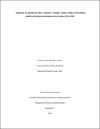Influencia del Tratado de Libre Comercio Colombia- Estados Unidos en el turismo, análisis del turismo colombiano entre los años 2012 a 2020
Fecha de publicación
2023-11-24Autor
Idioma del documento
spaResumen
El objetivo del presente trabajo es determinar el impacto que ha tenido el Tratado de Libre Comercio entre Estados Unidos y Colombia en el sector turismo de este último, para ello se centró la investigación inicialmente en analizar el sector en Colombia, sus ventajas comparativas y sus falencias, seguido de esto se investigaron e interpretaron diferentes capítulos del TLC que pudiesen afectar directa o indirectamente el sector para finalmente determinar el impacto a través de la comparativa de diferentes cifras en cinco años antes y cinco años después de la firma del tratado, resaltando el movimiento de los diferentes subsectores del turismo (hoteles, restaurantes, agencias de viajes, transporte) en aspectos tales como la inversión extranjera directa, el gasto turístico, entrada y salida de pasajeros y las ventajas arancelarias para la compra de suministros, de lo analizado de los subsectores, se observó que obtuvieron tendencias positivas, resaltando hoteles, con 32 establecimientos nuevos después de la firma del tratado, y transportes con seis nuevas aerolíneas abiertas en el país, en el caso de la inversión extranjera directa, dando como resultado un movimiento importante del sector en el país.
Abstract
The objective of this study is to determine the impact that the Free Trade Agreement between the United States and Colombia has had on the tourism sector of the latter. To do this, the research initially focused on analyzing the sector in Colombia, its comparative advantages, and its shortcomings. Following this, different chapters of the FTA that could affect the sector directly or indirectly were investigated and interpreted. Finally, the impact was determined through the comparison of different figures over five years before and five years after the treaty's signing, highlighting the movement within different subsectors of tourism (hotels, restaurants, travel agencies, transportation). This analysis considered aspects such as foreign direct investment, tourist expenditure, passenger arrivals and departures, and tariff advantages for the purchase of supplies. From the analysis of the subsectors, it was observed that they exhibited positive trends, particularly in the case of hotels, with 32 new establishments opening after the treaty's signing, and transportation, with six new airlines operating in the country, indicating significant growth in the sector within the country.
Palabras clave
Keywords
Colecciones
 Esta obra está bajo licencia internacional Creative Commons Reconocimiento-NoComercial 4.0.
Esta obra está bajo licencia internacional Creative Commons Reconocimiento-NoComercial 4.0.

